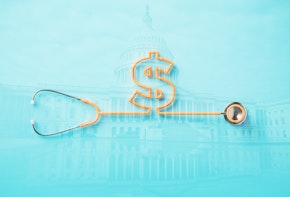Editor’s note: This blog first appeared on September 18th, 2019 in Health Affairs, available here.
The Affordable Care Act (ACA) expanded coverage to 20 million Americans and improved the quality of private health insurance for millions more. Low- and moderate-income individuals experienced the greatest coverage gains: the uninsurance rate dropped by almost 10 percentage points for those whose income is at or below the federal poverty level (FPL) and over 11 percentage for those just above the FPL. Much of this progress is attributed to Medicaid expansion and the availability of marketplace subsidies, the latter of which brought federal financial assistance to individuals purchasing private health insurance. Both policies are targeted to low- or middle-income people.
Despite this progress, significant premium affordability gaps remain, especially for those on the lower half of the income scale. These gaps persist because the Medicaid expansion and marketplace subsidies do not reach all low-income or middle-class individuals, either because they don’t qualify for assistance, do not know about subsidies, or because they struggle to afford coverage even with available subsidies. Of the 28.5 million people who were uninsured in 2017, almost 23 million earned below 400 percent FPL.
Furthermore, in that year, nearly 17 percent of people at or below 100 percent FPL (e.g., a family of four earning less than $25,000) and 12 percent of people earning between 100 and 300 percent FPL (e.g., a family of four earning up to $75,000) did not have insurance—and about half of uninsured people said they were uninsured due to cost. (And even those who did have health insurance still faced affordability gaps, created by high deductibles or excessive out-of-pocket costs; underinsurance is also a significant challenge not discussed in this post.)
Current proposals to expand access to coverage—such as state or federal public options, Medicaid or Medicare buy-in proposals, and single-payer plans—reflect a range of strategies to make premiums more affordable. Many of these proposals would also extend to people who are currently ineligible for ACA coverage or subsidies. This post discusses the impact that these different approaches would have on premium affordability for low- and middle-income families and individuals.
Affordability Considerations For Public Coverage Proposals
Given the high costs for millions of families (and the fact that health care costs are seen as a top priority for voters), there has been no shortage of new proposals to leverage public coverage to reduce premiums. Many of these proposals rely on some mix of decreasing provider reimbursement rates and profits, shifting risk to other types of coverage or markets, and expanding subsidies. We will discuss each of these approaches in turn.
Lowering Provider Reimbursement Rates
One way for a public option to reduce health care costs is to leverage projected market power to simply pay providers less. Private insurers and employers typically reimburse providers at rates that far exceed Medicare or Medicaid, and public options could generate savings by using lower reimbursement rates more closely tied to traditional public insurance. (A lower-premium public option plan could then, in turn, increase competition in the marketplace, driving down premiums for private competitors.)
To date, all of the federal public coverage proposals would base their provider reimbursement rates off of Medicare or Medicaid payment standards. States considering public options are similarly exploring rate setting that might hew to public rates. In addition to lower provider reimbursement rates, these proposals generally eliminate or limit profits and taxes, resulting in further savings. (This effect will vary based on factors such as whether the public plan is administered by private companies, and on current profit margins in the commercial market.)
Projections on the impact of lower provider reimbursement rates on premium affordability vary significantly:
- Washington’s new public option—which will be administered by private health insurers and sold through the state’s ACA marketplace—will reimburse providers by up to 160 percent of Medicare rates and is expected, in aggregate, to reduce individual market premiums by about 10 percent.
- In Colorado, Medicare-based reimbursement rates are projected to reduce premiums for a future public plan by about 15 percent as compared to the individual market, with additional savings from eliminating taxes and profits of between 6 and 10 percent.
- In New Mexico, analysts project that a Medicaid buy-in public option—that uses Medicaid rates and networks, and without profit margins—would have premiums between 15 and 28 percent lower relative to ACA marketplace options.
- Single-payer proposals assume that the government will pay Medicare rates or rates based on a negotiated global budget. Under the Senate and House Medicare for All proposals, enrollees would pay no premiums. Therefore, the cost for low- and middle-income consumers would depend on the progressivity of the financing mechanism.
The success of these efforts in bringing down premiums will depend in part on the reference rates that are used and how high the rates are in the private health insurance market. States with high provider rates, such as Oregon, could see a much greater impact in moving to a Medicare-based reference price than states with lower existing provider reimbursement rates.
Success will also depend on whether the public option can garner enough market share to convince providers to participate in their plan even at lower rates. Other factors include the payer and enrollee mix (including income level) in a given market as well as the possibility of cost-shifting to private insurers and employers (although recent research suggests that cost-shifting from Medicare to private health insurance is not inevitable or a foregone conclusion).
Because many low-income consumers receive ACA subsidies that allow them to pay based on their income, the effects of these rate reductions may be felt most by middle-income consumers eligible for minimal or no subsidies.
Risk Pool Migration
Insurance works by pooling risk. A larger risk pool helps keep premiums stable by better ensuring an appropriate balance between healthier and sicker people. Except for single-payer proposals (which would eliminate separate risk pools), public coverage proposals would generally maintain a multi-payer system. Having multiple payers—such as Medicaid, Medicare, and the commercial insurance market—affects the size of each risk pool and impacts premiums.
The effects of risk pool migration, where populations migrate from one risk pool to another, will be critical to understanding many of the public coverage proposals, which draw heavily on expansions of Medicare, Medicaid, and the individual market. For instance, states that have expanded their Medicaid programs have lower premiums in their individual market. A recent analysis of Medicaid expansion in Wisconsin confirms this trend.
Additional actuarial analysis is needed, but federal proposals that expand marketplace subsidies (and thus expand the risk pool) or allow older adults to buy in to Medicare (and thus reduce health care costs in the individual market) could have the added impact of improving the risk pool of the individual market, driving down premiums.
States must balance similar considerations with smaller populations. If, for instance, a Medicaid buy-in or public option proposal offers a narrower provider network, the buy-in might be more attractive to healthier consumers who are willing to accept a limited network in exchange for lower premiums. In developing a buy-in model in Colorado, actuaries assumed the buy-in would have a narrower network and that enrollees would be 10 percent healthier than individuals that remained in the individual market. While this risk mix would produce savings for the buy-in program, it would likely slightly increase individual market premiums as healthier people migrated out of ACA coverage and into the buy-in program. If the buy-in is part of the individual market single risk pool, this effect could be mitigated by the ACA’s risk adjustment program. Low-income consumers may feel these effects less because they are insulated from premium increases due to marketplace subsidies.
To address potential market uncertainty and help sustain a robust risk pool, some proposals, such as Medicare X, include reinsurance to insulate insurers from heavy losses if they attract a higher-risk population. A renewed federal reinsurance program for the ACA would reduce premiums nationwide and would most significantly help middle-income people who are not subsidy-eligible. For 2020, 12 states are expected to operate state-based reinsurance programs under ACA waiver authority.
Expanding Subsidies And Discounts (Up to Free)
Several public coverage proposals would expand the eligibility for subsidies to purchase both the public option and private competitors. Expanded subsidies are likely critical to expanding coverage to additional low- and middle-income consumers, many of whom remain uninsured even with available ACA subsidies. Examples of incorporating expanded subsidies (or offering sliding scale premiums) into public coverage expansions include:
- As part of its public option bill, Washington will expand premium tax credits to people earning up to 500 percent FPL and limit premiums for individuals at 500 percent FPL to 10 percent of income.
- Many federal proposals would allow individuals to receive subsidies or pay reduced rates for premiums at higher incomes than currently allowed, or would eliminate income limits on those discounts altogether. Medicare for America would offer sliding-scale premiums at all income levels and cap premiums at 8 percent of income, while the federal Medicaid buy-in proposal would cap buy-in premiums at 9.5 percent of income for all income levels.
- Single-payer proposals in the House and Senate would eliminate premiums altogether, effectively subsidizing 100 percent of premiums regardless of income.
Some federal proposals would additionally make subsidies more generous. Medicare Part E, for instance, would peg subsidies to more comprehensive gold coverage (rather than silver coverage), thereby increasing the generosity of premium tax credits. Other proposals would reduce the contribution that individuals must make towards premiums. Medicare X, for example, would require an individual earning 200 percent FPL to contribute 5.8 percent of their income towards premiums (down from 6.5 percent under the ACA).
Expanding Eligibility For New Coverage Options
Proposals to expand the availability of public coverage should also account for the fact that the ACA includes some significant eligibility gaps. These include the failure of some states to expand Medicaid to cover all people up to 138 percent FPL after the Supreme Court made the expansion voluntary; the lack of coverage options for undocumented individuals; and the “family glitch” under which an employee’s family members are deemed ineligible for marketplace subsidies as long as the employee is offered affordable, self-only employer-based coverage, even if family coverage through the employee’s workplace would be unaffordable. New proposals that fail to account for these gaps will continue to leave millions of low- and middle-income people uninsured.
Closing The Medicaid Gap
To date, thirty-six states and Washington, D.C. have expanded their Medicaid programs to extend coverage to millions of low-income childless adults. Fourteen states have declined to do so. This leaves billions in federal funding on the table and a total of 2.5 million people in the “Medicaid coverage gap”—the dead zone between the maximum income threshold for Medicaid eligibility (or zero income for childless adults in states where they are not eligible for traditional Medicaid) and qualification for market subsidies at 100 percent FPL. Individuals earning between 100 and 138 percent FPL may be eligible for subsidized marketplace coverage, but this coverage is not as generous as Medicaid.
Some, but not all, public coverage proposals would effectively close the Medicaid gap. Proposals such as Medicare for America and Medicare for All would provide free public option coverage to individuals who fall within the Medicaid coverage gap. Other proposals, such as Medicare X, would heavily subsidize coverage for people earning less than 138 percent FPL. Federal proposals could also further encourage states to close the gap themselves or to allow cities and counties to expand Medicaid on their own.
Expanding Options For Undocumented Individuals
About one-quarter of the uninsured are non-citizens (either lawfully present or undocumented). While undocumented individuals are just as likely to be in a family with an employed individual, they are almost twice as likely to be low income, working in jobs with limited access to insurance. These individuals are also barred from Medicaid, CHIP, and marketplace coverage. As a result, this population is five times as likely as citizens to be uninsured.
States can expand access to this population but must, for the most part, use their own funds and cannot rely on individual marketplaces in the absence of a waiver. This year, California expanded parts of its Medicaid program using state dollars for income-eligible undocumented individuals under 26.
Few federal proposals provide details on how undocumented individuals would be affected. Single-payer proposals explicitly offer coverage regardless of citizenship but allow the federal government to further define eligibility requirements. Other proposals—such as Medicare Part E and Medicare for America—would offer coverage to all residents but similarly leave discretion to the federal government. To the extent that proposals incorporate ACA restrictions, they would presumably exclude undocumented individuals from subsidized or marketplace coverage.
Fixing The Family Glitch
Addressing the so-called “family glitch” would mean clarifying that an offer of “affordable” job-based coverage for an employee does not bar that employee’s family from being eligible for marketplace subsidies. Doing so could extend marketplace subsidies to between 3 and 6 million people under 400 percent FPL, saving them thousands of dollars annually and boosting economic security for low-income families.
Proposals that do not rely on the existing premium subsidy model, such as single-payer proposals or Medicare for America, would automatically end the glitch. But while new public coverage proposals may offer cheaper unsubsidized premiums for families affected by the glitch, many of these proposals—such as state public options and Medicare X—still incorporate existing ACA subsidy restrictions, including the family glitch, leaving millions of low- and middle-income families locked out of the further savings that come with subsidies.
Public coverage proposals require intentional policy design to improve affordability for low- and middle-income families. Their success in lowering premiums and moving toward universal coverage may depend on how aggressive they are in bringing down health care costs, how heavily they subsidize coverage, and how expansive their eligibility rules become.











